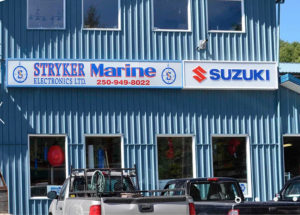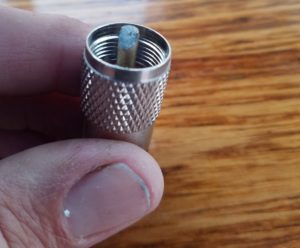Port Hardy, BC Canada, 6-MAY-2018 – I spent a good part of Friday at the top of our mast reinstalling our antenna and the cable that leads from it through the mast through the engine compartment through the bilge and into the basement where the cable connects to a signal splitter.
I spent enough time at the top of the mast that another boat owner spoke with Jennifer and offered to pay me to go to the top of his mast. I was flattered, but not tempted.
In Friday Harbor, we had bought and installed an 8 foot whip antenna as a temporary solution for our failed masthead antenna. We started showing up again on AIS. The harbor master in Port Hardy, where I sat atop the mast like a Christmas Angel, spoke to us through our VHF.
Once we settled in on the public docs, which are better and 40% cheaper than the private docks, Jennifer and I decided to walk to the supermarket. A week earlier on the advice of SEA electronics in Campbell River, I called Doug at Stryker Electronics to ask whether he could fix our antenna. He replied, “that is what we do.” And told me to call him once we were docked in Port Hardy.
 The moment we were settled I called Stryker and spoke with Lee, who said she had added me to the list and that we should see someone later in the day. We found things to do to fill the day until 5 PM, but no one from Stryker showed up.
The moment we were settled I called Stryker and spoke with Lee, who said she had added me to the list and that we should see someone later in the day. We found things to do to fill the day until 5 PM, but no one from Stryker showed up.
Port Hardy is about as far north as you can go on the east side of Vancouver Island. The town has two major roads, one of which runs along the water and past the harbor. The marina is on one side of that street and Stryker’s on the other.
Although I was resistant to doing it, Jennifer prodded me into going to Stryker in finding out why they haven’t shown up on our boat.
Behind the counter was Doug, though at this moment I didn’t know his name. Doug is an imposing figure. six-foot two, six-foot three, built like an ex-football player with a big hard belly, a walrus mustache, and a deep, purposeful voice.
Doug told me, rather than explained to me, that many other boats had made appointments, the season was about to open (which is why I couldn’t get anyone to fix the antenna in Campbell River), and I would have to wait.
I’ve lost my wallflower, Casper Milquetoast demeanor over the years. I countered that I’d called a week earlier to set up an appointment, and in fact I had spoken to “you, Doug. You told me to call when I got here.”
Doug looked at me, and then called to a tech behind the counter, asking him to go with me and ‘‘take a look at this.’’ It was 6 PM.
Doug introduced me to Gilbert. Telling me that Gilbert was his best tech, and that I should not steal Gilbert away from him.
Gilbert is an Asian man, that I somehow mistakenly thought was Japanese, wearing a Stryker hat and standing 5′ 2″. Doug handed Gilbert an 8 foot whip antenna, the same make and model we had, plus the same make and model mast top antenna we had.
Gilbert loaded up his Toyota Camry with the two antennas, me and the tool bag. He suggested Jennifer she walk to the dock across the street.
We parked at the end of the dock at the top of the long, nearly vertical gangway. There was a laser-printed sign prohibiting parking after 7 PM because the fire department would be practicing.
Gilbert correctly told me he would be gone by then.
For the next twenty minutes, Gilbert tested things in a manner that told us either he was a rank beginner who knew nothing about what he was doing, or he was a very experienced expert who knew exactly what he was doing and was not worried about looking the least bit professional.
After testing output on the radio, and reception through our installed whip antenna, he asked me to hold two wires from the new whip antenna against the connector on the radio while he did the VHF equivalent of divining for water. After a few moments, he told us that our whip antenna was fine, but the position was interfering with its ability to work because of all of the stainless steel wire that makes up our rig.
He told us we really needed the mast antenna, that I should come by the shop at 9:30 the next morning, and that he would go up to the top of the mask to check the antenna.
After he left, I commented to Jennifer that I thought it was very odd that he would use our gear to go to the top of the mast. I was very surprised that any employer would allow an employee to do this.
We reported at 9:30, where it became clear that Doug was not going to allow Gilbert to climb to the top of our mast, and that we were not going to debug the antenna, but we, in the form of me, were going to climb to the top of the mast, replace the antenna and the cable, and then return to the store to fetch Gilbert, who would attach a second connector, and certify that the antenna was working.
After some back-and-forth between Doug and Gilbert, Gilbert cut 100 feet of 8X coax cable, attached a PL-259 connector, handed me the wire and a replacement mast-top connector, told me I would do good work and sent me on my way. Doug said we would settle up when all was done.
In the past, to send me up we would use the mainsail halyard to lift me, and the jib halyard as a safety. The last time I was up at the masthead Jennifer and I, with the help of Harrison, installed a second jib halyard. This one is made of dyneema with a polyester tail. With these two halyards on the same side of the mast it seemed to be, and was, a much better way of going to the masthead.
There is an interesting problem with a halyard that is dyneema with the polyester tail. The tail weighs much more than the dyneema halyard. Let go of the halyard and it runs skyward to the top of the mast. Neither Jennifer nor I let go of the halyard, but it was a problem I hadn’t anticipated. Now, the obvious answer is to put a weight on the end of the dyneema so that it weighs as much as the polyester tail. However, there are unintended moments, however rare, when one might let go of the halyard and have the end fly through the air striking anything in its path, normally the head of the person who let it go. The choices at this moment are whether to have a halyard that if released flies to the masthead, or to release the sailing equivalent of flying mallet across the foredeck of Caro Babbo. I haven’t made a final decision, but I’ve not implemented the flying mallet.

The top of the mast is a very interesting place to spend time. It affords a view that isn’t available out of four-story window. Nor is it quite the view from a rooftop. The view is a true 360° spherical view of the world that conically sways with the wakes of passing boats and Jennifer’s movement around the deck.
About two thirds of the way through my time as a flagpole sitter, a prawn boat tied up on the other side of the dock.

